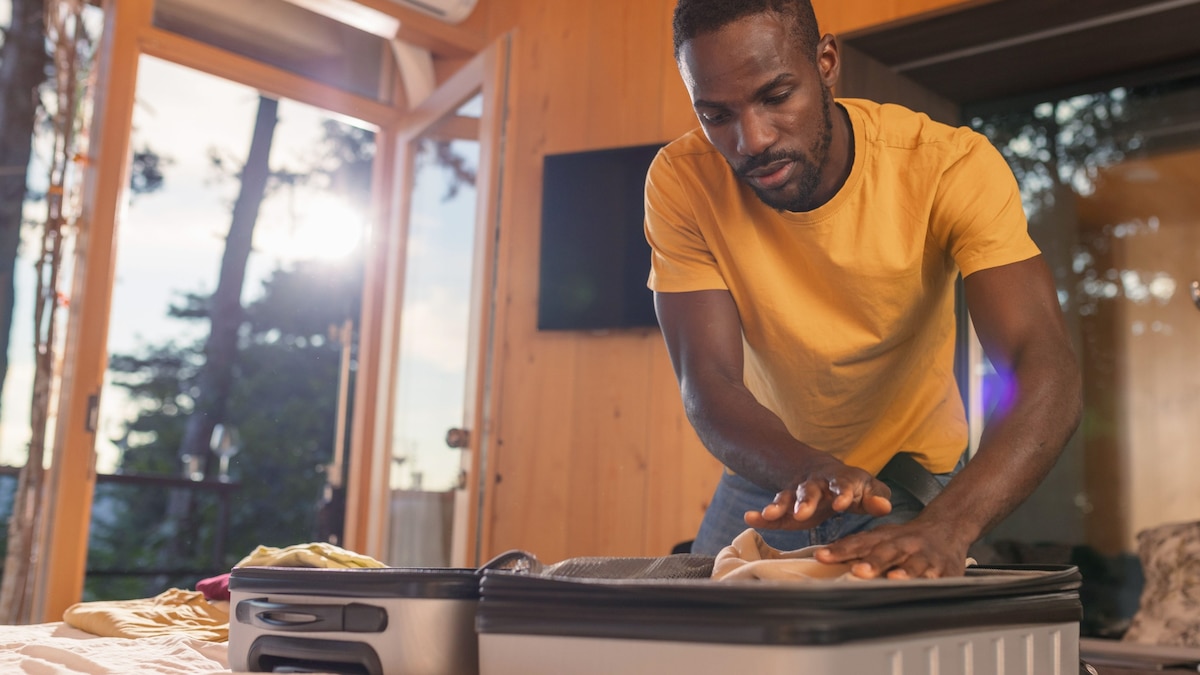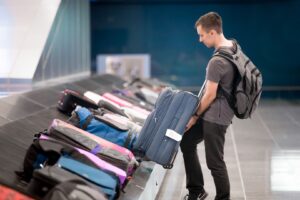How to pack light for a weekend trip
8 min read
By clicking on the featured links, visitors will leave nationalgeographic.com and be directed to third-party e-commerce sites that operate under different terms and privacy policies. As a participant in multiple affiliate marketing programs, National Geographic will earn a commission for certain purchases. See full disclaimer below.*
Packing light for a weekend trip is all about strategy and being intentional. By planning ahead, prioritizing multifunctional clothing, and sticking to a small weekender bag, you can pack everything you need without feeling weighed down.
“Packing light is about more than saving space, it’s about cultivating mindfulness,” says Shira Gill, organizing expert and author of LifeStyled: Your Guide to a More Organized & Intentional Life. “By choosing multifunctional items and focusing on what you truly need, you reduce your environmental impact, avoid travel stress, and create room to enjoy your trip.”
How to pack light for a weekend trip—step by step
Packing light for a weekend trip requires strategy, versatility, and a bit of discipline. A little advance planning helps too.
“Think about what you’ll want to pack for a weekend trip at least a couple of days out,” advises Lydia Mansel, creator of the packing newsletter, JustPacked. That way, you won’t feel stressed and, perhaps more importantly, forget key items.
Step 1: Start with a packing list.
A thoughtful packing list ensures you’re prepared and that your travel bag is organized. Start by tailoring your list to match your trip, factoring in weather and planned activities.
“Think through your trip’s itinerary and draft up at least a basic outline of what you’ll need to pack,” adds Mansel. “I typically jot down my packing list … and add or remove items before I begin the physical packing process.”
A packing list does more than help prevent overpacking. It ensures you don’t leave behind critical items. Whether you use a pen and paper or a packing app like PackPoint or Notes, organizing your items ahead of time can help you save space and avoid a last-minute scramble.
Our pick: Packing List Note Pad
This 60-sheet tear-off note pad organizes everything you need to bring with you. From clothes and toiletries to extras like reading materials, hand sanitizer, and ear plugs, this list makes it easy to check off items as you pack.
Step 2: Choose a small, durable suitcase.
A compact travel bag is your secret weapon for packing light. Limited space helps keep the focus on essentials so you don’t overpack with “just in case” items.
Look for a bag that prioritizes organization with plenty of compartments. It should be made of high-quality materials, such as polycarbonate or recycled polyester, and have comfortable handles. Some sort of water resistance, whether via high-tech materials or a PFC-free coating, may help bags last longer.
Our pick: Béis The Small Carry-On Roller
The Small Carry-On Roller features a polycarbonate hard shell and a minimalist look. Smart touches like an expandable zipper, thoughtfully designed compartments, and compression straps keep belongings organized. A built-in weight indicator helps ensure you won’t overpack. This stylish roller comes in seven colors, including black and olive.
(These 10 weekender bags make it easy to travel light)
Step 3: Pack with compression cubes.
Compression packing cubes are wonders for saving space, helping you pack smarter without adding bulk.
“Compression cubes are the only way to go if you’re going to buy packing cubes,” says Anne McAlpin, a travel and packing expert who shares her tips at Pack It Up. “In my opinion, you can save … up to two-thirds of the space,” noting that compression cubes can squeeze out excess air.
Start with versatile clothing, especially layers that mix and match within a neutral color palette. Stick to no more than three colors or patterns.
For best results, roll your clothes instead of folding them to minimize wrinkles and save space. Categorize items by type (shirts, pants, socks) and pack each group into a cube, starting with the largest items in the biggest cube.
Our pick: Bagail Ultralight Compression Packing Cubes
Made from water-resistant fabric, these cubes compress clothes to create extra space in your bag. Multiple sizes accommodate everything from shirts to accessories. There’s even a dedicated shoe bag. The exterior zipper allows for easy compression, which according to the manufacturer, can give you up to 50 percent more space in your bag.
(Packing cubes changed the way we travel. Here are our favorites.)
Step 4: Use reusable travel-sized toiletry bottles.
Skip the travel-size aisle and go for reusable, TSA-approved containers for personal care items, like shampoo, conditioner, and moisturizer.
“Decant liquid essentials into reusable travel-size bottles, and pack them in a clear, resealable pouch for security checks,” says Gill, who also recommends toting solids, like shampoo bars, whenever possible.
Store everything in a waterproof bag to prevent spills and keep your travel bag organized. This approach minimizes waste, saves space, and avoids the bulk of full-size toiletries.
Our pick: Tocelffe 18-Pack Travel Bottles for Toiletries
This TSA-approved toiletry set includes a range of mix-and-match sizes, including squeeze bottles, spray bottles, and cream jars. A waterproof toiletry bag keeps everything organized and helps prevent unexpected leaks from spilling onto your clothes.
Step 5: Limit shoes to two pairs.
Footwear can add bulk and weight to your travel bag. Limit yourself to no more than two pairs: One versatile option for activities, like walking tours and museum visits, and one activity-specific pair, such as flip-flops or hiking boots. “Don’t get crazy with your shoes,” advises McAlpin. “I do a fancier shoe and then a sneaker.”
Our pick: Allbirds Tree Dasher 2 (women’s; men’s)
For versatility, we like the Allbirds Tree Dasher 2, a supportive, active shoe. Allbirds are comfortable, but not overly casual. To save space, wear the heavier pair while traveling.
Our pick: JJ Power Travel Shoe Bags
These waterproof travel shoe bags are great for keeping dirt and moisture away from clothing. The breathable mesh top promotes air circulation, helping keep your shoes fresh.
Step 6: Invest in a quality carry-on backpack.
A smartly designed backpack can help keep you avoid overpacking. Look for one with a wide opening and multiple pockets to keep small essentials, like electronics, books, and toiletries, within reach.
Choose a backpack designed to fit under an airplane seat. Some makers label the bag as “underseat approved,” meaning it complies with most airlines’ personal item size regulations. But it always pays to check your specific flight, as planes and airline carrier rules vary.
Our pick: Bagsmart Blast Quick Access Carry On Travel Backpack
Bagsmart’s backpack features durable construction and an abundance of pockets. It has compartments for shoes and laptops and compression straps to keep everything in place. A standout feature is the back-opening design, which makes packing a breeze. This pack comes in eight colors and two sizes, including standard (28L) and extended (38L).
(8 top-notch backpacks for traveling light)
Step 7: Organize accessories.
Small items, like jewelry and tech cords, can easily get lost or tangled. Dedicated pouches keep everything organized and easily accessible.
When it comes to jewelry, Gill suggests “only a few classic pieces, like gold hoops or a minimalist necklace. Store them in a small zippered pouch or travel jewelry roll to keep them organized and protected. Better yet, wear them and pack nothing.”
Our pick: Travelon Accessory Organizer
This organizer has three transparent compartments to keep your smallest items, like earrings, charging cords, and earbuds, safely tucked away. The slim design easily fits into a carry-on or backpack. Durable fabric and zippered closures help keep everything secure.
Step 8: Skip the bulk packaging.
For a weekend getaway, leave full-size bottles of prescription medications and vitamins at home. Pack what you need, plus a few extra doses to cover unexpected delays or extended stays.
Smaller, travel-size containers can save precious space. A dedicated pill organizer is also a smart choice for managing medications, helping ensure you take the right doses on the right days.
Our pick: Auvon Weekly Pill Organizer
The Auvon organizer has seven compartments and dividers for day and night doses. It lets you pack just what you need for a quick getaway. Snap-tight lids are designed to keep pills secure, preventing spills in your bag.
(Think you know what you can pack in a carry-on? Here’s what TSA says.)
Step 9: Pack a spot cleaner.
When you’re packing light for the weekend, a travel-size spot cleaner can make a big difference. It’s just right for quickly removing small stains, helping extend the life of your clothes while you’re on the road.
Our Pick: Tide to Go Instant Stain Remover
Tide’s pen-sized stain remover can handle small food and drink stains, sparing you the need for a full wash. Plus, it doesn’t take up any space. Just tuck it into a pocket.
Step 10: Weigh it all with a digital luggage scale.
A digital luggage scale is a smart tool for keeping your bag weight down before you head to the airport. That way, you’ll avoid expensive weight limit surprises at check-in.
Our pick: Dr.meter Digital Luggage Scale
This lightweight digital luggage scale weighs luggage up to 110 pounds. It has a bright LCD display and allows for quick conversions between pounds and kilograms.
(Here are the best carry-on bags for your next trip)
What to know about packing light for a weekend trip
Packing light for a weekend can transform your travel experience, making it smoother, more enjoyable, and less stressful. Here are some key tips to streamline your packing:
Pack versatile clothing
Pick out items that easily mix and match, so you can maximize the number of outfit combinations. “Choose a neutral color palette with one or two accent colors” advises Gill.
Stick to essentials
Trust yourself and focus on what you really need for the trip. Leave behind “just in case” items, like a sewing kit or extra pairs of socks.
Minimize toiletries
Pack personal care items, like shampoo and hand lotion, in reusable travel-size containers. This saves space, while reducing waste.
Maximize space with compression
Compression packing cubes allow you to save space while keeping clothes organized.
Frequently asked questions
How can you pack light for a three-day trip?
Start with a small, versatile travel bag and stick to a color palette that makes it easy to mix and match outfits. Opt for multifunctional clothing, like jeans that can be dressed up or down or a reversible belt. Roll clothes to save space. Keep toiletries to a minimum with travel-size containers and limit shoes to two pairs.
How do you pack minimally for a weekend?
Start by editing your items. Consider planned activities and only bring what you will actually wear. Factor in weather at your destination and pack just enough, leaving room for any spontaneous purchases or souvenirs.
“Write your activities based on the days,” advises McAlpin. “Then work backwards from that. Life is more casual. People take too many fancy outfits when they travel.”
How do you pack for a three-day trip in a carry-on?
For a three-day trip, pack versatile clothing in neutral tones that easily pair together. Use compression packing cubes to keep everything organized and compact and roll your clothes to maximize space. Use travel-size toiletries and limit accessories.
*Although we are sharing our personal opinions of these experiences or products with you, National Geographic is not endorsing these experiences or products on behalf of anyone. It has not performed product safety testing on any of these products, did not manufacture them, and is not selling, or distributing them and is not making any representations about the safety or caliber of these products or experiences for individual consumers. Prices and availability are subject to change from the date of publication.



